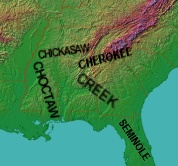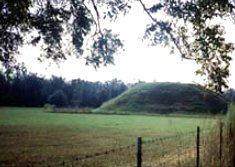 |
| NHC Home |
|
The Effects of Removal on American Indian Tribes Clara Sue Kidwell, University of North Carolina at Chapel Hill ©National Humanities Center |
|
(part 2 of 7)
The Choctaw, Chickasaw, Cherokee, Creek, and Seminole tribes lived originally in the area that now encompasses the states of Mississippi, Alabama, Georgia, Tennessee, and North Carolina. These groups defined their own identity in many ways, but an important one was their relationship with the land that they considered their home.
| The Choctaw territory in present-day Mississippi extended from the Mississippi Delta on the west, through rich, black soil prairie lands in the northeast, to piney woods in the southern part of the state. Its eastern boundary was defined by the watershed of the Black Warrior River, and the Pearl, Tombigbee, and Chickasawhay Rivers defined its three major divisions—the Okla Falaya, the Okla Tanap, and the Okla Hannali (Okla being the Choctaw word for "people"). |
The Creeks lived in Alabama and southwestern Georgia— |
The Chickasaw homeland was in the upper Mississippi Delta region in northern Mississippi, into western Tennessee and northern Alabama. The Cherokees occupied the valleys of the southern Appalachian Mountains, establishing villages along the Tennessee River and its tributaries. They included five divisions (as defined by the British colonial government in the 1700s): the Lower Towns in north Georgia, the Over-the-Hill (or Overhill) Towns in eastern Tennessee, and Middle Towns, Valley Towns, and Out Towns in western North Carolina. |
|
The Seminoles, originally of Lower Creek identity, emerged as a distinctive tribal group in the early to mid 1700s as a result of conflict between European colonists and tribal villages. A major uprising by tribes along the east coast of Georgia, the Yamasee Rebellion of 1715, led to military action on the part of the British that destroyed native villages and dispossessed their populations. Homeless groups moved south into Spanish Territory below the 31st parallel (which became Florida), as the Spanish were reputed to have a liberal policy toward Indians and to leave them in peace. The Indian groups that settled in what is now Florida and the southern portions of Georgia, Alabama, and Mississippi, came to be called Seminoles, a corruption of the Spanish term "cimmerones" or wanderers. |
|||
Each of these tribal groups had its own origin tradition.
The Choctaws and Chickasaws shared a common origin tradition, that they had lived west of the Mississippi River and had migrated to the east. The migration was the result of the dream of a holy man that the sacred pole that stood in the center of his village would lean in the direction of the march. It was led by two brothers, Chata and Chiksa. During the long journey and after the people crossed the Mississippi, the brothers and their followers were separated-by disagreement, in a thunderstorm, the accounts vary. Chata and his people followed the pole until it finally stood upright near a hill. The site today is at Nanih Waiya, a flat-topped mound about twenty miles north of Philadelphia, Mississippi, the tribal headquarters of the Mississippi Band of Choctaw Indians.
The Cherokee origin tradition explains the formation of their homeland—the hills and valleys of the southern Appalachian Mountains, along the Tennessee River and its tributaries. When the earth was created and the land was very soft, birds were sent down from the sky to find a dry place for the animals to live. When they were unsuccessful, a giant buzzard was sent to continue the search. As he grew tired he flew lower and lower, and his wingtips began to hit the soft new land, pushing down the valleys and raising the hills.
The Creeks occupied villages along the Chattahoochie, Tallapoosa, and Coosa Rivers in Alabama. Their origins began under a mountain in the west, which opened up and the people emerged and settled nearby. But the earth opened up and ate their children, and they began a long march to the east, crossing several rivers. They encountered three other peoples, from whom they learned the use of certain herbs. They also found a pole on a mountain, which became their guide. They finally encountered a white path, which they followed to Caloose Creek. They found the people who had made the white path and settled near them. The story explains not only how the Creeks came to the southeast but how they came to dominate most of what is now the state of Alabama by making alliances with tribal groups whose hunting territories they wanted. The Creeks were a confederacy of peoples held together by similarity of language.
| "Native Americans and the Land" Essays |
| Pleistocene Die-Off |
The Columbian Exchange | Indian Removal | Buffalo Tales Essay-Related Links |
TeacherServe Home Page
National Humanities Center
7 Alexander Drive, P.O. Box 12256
Research Triangle Park, North Carolina 27709
Phone: (919) 549-0661 Fax: (919) 990-8535
Revised: September 2010
nationalhumanitiescenter.org



